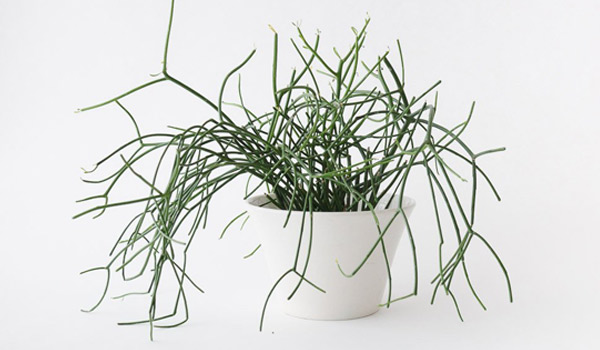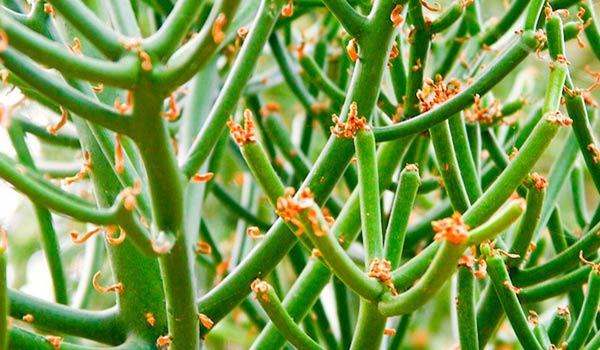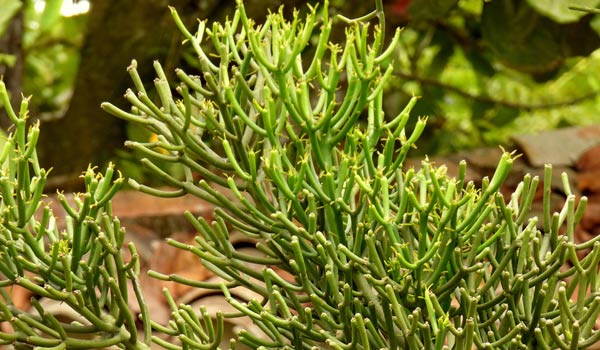Pencil Cactus Care (Euphorbia)

Despite its name, the pencil cactus is not actually a cactus, but a euphorbia. There are thousands of euphorbia, and all of them when injured, release an irritating milky white latex sap. Because of this feature, some people think that it is better to consider other cacti to grow rather than the pencil cactus AKA stick cactus.
However, this plant is far more gorgeous to be ignored. In this article we’ll tell you all about pencil cactus care indoors to caution exercises you need to grow this plant safely.

Pencil Cactus, Habitat and Appearance
Originally native to arid South Africa and India, Euphorbia tirucalli grows in semi-arid tropical climates. It can also be found in some surrounding islands and the Arabian Peninsula, Brazil, India, Sri Lanka, Vietnam, the Philippines, and Ghana.
This succulent has many names, including:
- Pencil cactus or pencil tree
- Stick cactus
- Aveloz
- Indian tree spurge
- Naked lady
- and milk bush
In its natural habitat, this shrub can grow to more than 20 feet. It has cylindrical succulent branches that are that resemble pencils. They are green, fleshy, fragile, and have a thickness of roughly 0.3 inches.
Does a pencil cactus bloom? Yes. The end of this branches is where the yellow flowers of the pencil cactus appear in late spring to summer. These slender also contain the notorious sap that causes irrigation.
Is Pencil Cactus Toxic?
As a member of the Euphorbia family, stick cactus produces a thick white latex sap that is toxic for both humans and animals. When it contacts the skin, it causes redness, rash, swelling, burning, itching, or blisters. And if it gets to the eyes, it can even cause temporary blindness.
Some people find this sap extremely irritating, and some believe that it is not that severe. Nevertheless, the best practice is to always wear protective gloves and eye protection gear; and to keep it out of reach of children and pets.
Tip: wear disposable gloves on the protective ones, and throw them away when handling is finished.
In case of ingestion, severe burning of the lips, mouth, and tongue are among the first symptoms. It can also lead to vomiting, diarrhea, and even anaphylaxis. If ingested or contacted with the eye, seek medical help as soon as possible.
Pencil Cactus Sap on Skin Treatment
If somehow your skin comes in contact with the sap, wash the area with cool water immediately. Be careful not to wash the sap down onto other parts of your skin.
Also, we don’t recommend taking hot (or even warm) showers after handling stick cactus right away. This can spread the sap instead of removing it causing more skin irritation.

Pencil Cactus Benefits
The sap can make this plant quite scary, but it actually has multiple uses and benefits. The stick cactus grows in dry areas and is frequently used to feed cattle or as hedging.
Other pencil cactus benefits include medical uses that are common among cultures in Brazil, India, and Malaysia. They use this succulent as a remedy for various diseases including asthma, cough, earache, neuralgia, rheumatism, toothache, and cancer.
Pencil Cactus Care
The requirements of stick cactus make it another low-maintenance succulent that is easy to grow. It copes with neglecting owners very well and is resistant to drought periods, pests, and diseases.
Water
Water your milk bush every 2 to 3 weeks in the spring and summer. During fall and winter, water it once every month. Similar to other succulents, it is a good idea to let the soil dry out completely in between irrigations to avoid overwatering and root rot.
Light
The pencil cactus grows best in full sun, tolerating some shade as well. It loves the sunlight, but it appreciates if you protect it from the hot afternoon sun. For pencil cactus care indoors, place its pot by the brightest window in your house.
Pencil Cactus Soil
Pencil cactus soil should be dry, sandy soil. It would be even better if the soil isn’t very rich in nutrients. Any succulent or cactus potting mix that doesn’t retain excess water is suitable for Euphorbia tirucalli.
Temperature
Warm temperatures from 65 to 75 degrees Fahrenheit are ideal for stick cactus. Temperatures below 50 degrees Fahrenheit can cause some problems for this plant. For pencil cactus care indoors, protect it from cool drafts, whether it comes from the outside or from your air conditioner.
Humidity
Spots with low humidity are what this plant prefers. But as long as the pencil cactus soil is well-draining doesn’t retain moisture, it can tolerate higher humidity levels.
Feeding
As you can guess from the soil the milk bush needs, it doesn’t fertilization much. You can fertilize your plant every year with a liquid houseplant fertilizer in the spring.
Repotting
When the roots have filled the container, it’s time to repot your plant. Make sure the pencil cactus soil is dry before repotting. Gently remove the plant from the pot, and brush the excess soil off. Trim shriveled and rotten roots off and place the cactus in the new pot. Fill around it with fresh potting mix. Start watering after a week.
Always go for unglazed clay pots with drainage holes for repotting a Euphorbia tirucalli, especially if it’s tall. A clay pot absorbs any excess water and lets it evaporate.

Pencil Cactus Propagation
For a quick result, we recommend propagating using the stick cactus cuttings. After wearing long sleeves, eye protection, and disposable gloves, follow these steps:
- Using a sharp and clean knife, cut off a 6-inch long stem of the cactus at an angle.
- Stop the sap flow carefully by dipping the cutting in water or wrap the end in a towel.
- Let the cutting dry out for a month (or longer) until it forms a callous over the cut end.
- Plant the stick cactus cutting in moist succulent or cactus potting mix and don’t water it for a week.
Milk bush has a fairly fast growth rate compared to many other succulents, and its cuttings turn into beautiful and small shrubs in no time.
- In this post:
- Pencil Cactus, Habitat and Appearance
- Is Pencil Cactus Toxic?
- Pencil Cactus Benefits
- Pencil Cactus Care
- Pencil Cactus Propagation



